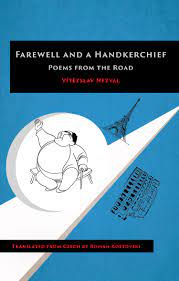by Nicole Yurcaba

In 1933, Czech poet, writer, and translator Vitezslav Nezval traveled to Vienna, Paris, Southern France, and Italy. Nezval’s travels allowed him to form friendships with surrealist poets Andre Breton and Paul Elard, and Nezval eventually returned to his native country and established the foundations of Czech realism. As one of the most prolific Czech surrealists, Nezval left a long legacy of groundbreaking writings, including Farewell and a Handkerchief: Poems from the Road.
Described as a “proving ground for Nezval’s own shift from poetism to surrealism,” Farewell and a Handkerchief: Poems from the Road displays Nezval’s mastery of observation, and dream-like hallucinations receive the same attention as an Italian landscape’s beauty. In this collection, cities, people, objects, the rich, and the poor stand on the brink of a Europe approaching Nazism and massive social upheaval. The poems, like polaroids in a scrapbook or photo album, stand as individual snapshots of the beauty, the roughness, the despair, and the quiet.
Poems like “Ringtsrasse” are Baudelairean in tone and subject matter. Opening with the (at that time) shocking line “A larva shows her naked belly,” the poem celebrates the often overlooked and the twisted. The natural world balances with the human-made one as the larva flashes “her gaudy trinkets” and “The lamp winks dandily.” The speaker directly addresses death in a single command which cinches the poem’s conclusion: “Fancy Death, cover your belly!” The speaker’s personification of death at this point is not only clever, but a gentle reminder about the fate which awaits everything. Similarly, the poem “Traffic Rules” is a metaphor for existence. Violence and frivolity clash, and the poem’s emotional grip tightens because of its twinned first and last stanzas: “At this carnival’s gigantic shooting range / The traffic office shouts Halt!” While these stanzas bookend the poem, the central four lines carefully balance life and death. The speaker declares “dead automobiles” as “beautiful” and references the Pompeii disaster. The speaker describes automobiles’ horns as a “resurrecting sensation.” Again, the speaker brings readers to the precipice where life meets death and the afterlife and challenges them to contemplate their mortality.
And what better place to contemplate the mortal coil than in one of France’s famous cemeteries where Baudelaire himself rests? In “By the Wall of Montparnasse Cemetery,” the speaker transitions to a confessional, vulnerable tone. The speaker commands the audience “So carry on” and demands readers to “hail this king who is long gone.” The speaker lapses into an intimate, salutatory conversation opening with “My dear poet.” Again, death becomes the conversational focus as the speaker offers, “Death is not the greatest evil” as they contemplate whether or not, if Baudelaire still lived, hearing his poems recited would drive him insane.
One of the collection’s most philosophical and poetically elegant sections is “Aquarium.” Divided into nine subsections consisting of poems of various lengths, “Aquarium” is imagistic, experimental. The section’s intensity lies in its duality. Some readers interpret the aquarium and its inhabitants as a metaphor for life and individuals; others may accept it and its inhabitants straightforwardly. Experimental forms and structures separate “Aquarium” from the other poems in Farewell and a Handkerchief, which typically harbor rhyme schemes and traditional stanza structures. In particular, subsections “1” and “9”—the first and last poems in “Aquarium”—rely on experimentation. Nonetheless, the experimentation does not overshadow the sections’ philosophical offerings. “1” offers the Emersonian ideal “That nature controls / Every pond, however soiled it may be.” “9” takes a more existentialist approach: “Ask me what is the purpose of these colorful patterns / Produced by either insanity or by another more ideal / life form.” The poem’s structure ebbs from long lines to a brief two-word line and then into longer lines. However, the speaker’s contemplations are more than just another experimental poem questioning one’s purpose. The poem concludes with the lines “And why shouldn’t poetry / Have this same reason to exist / as an aquarium?” While “Aquarium” isn’t the only poem in which the speaker argues poetry’s importance in society, it is the most distinctive, establishing poetry as a realm separate from human existence into which few receive entrance.
The eponymous poem “Farewell and a Handkerchief” closes the collection. Utilizing a traditional structure and language, the speaker’s repetition of the word “Farewell” throughout the poem creates a finality unlike any other in the collection. The speaker adopts a futile tone, asserting, “So much for my hopes–nothing else is left” and “Leave it to fate!” The speaker’s words glean eerily prophetic in the context of the horrors Europe would endure in a few short years.
Of course, would collections like Farewell and a Handkerchief exist if publishers like Plamen Press and translators such as Roman Kostovski didn’t bring them to the English-speaking world? Probably not. Plamen Press is a small, mighty press focusing on the promotion of and translation of literature from Central, Eastern, and Southeastern Europe. Their translations are high-quality and never disappointing, and Farewell and a Handkerchief is only one of their many translated gems. Be sure to keep an eye out for my future review of another Czech classic and Plamen Press must-read, Viktor Dyk’s The Ratcatcher.
Nicole Yurcaba (Ukrainian: Нікола Юрцаба–Nikola Yurtsaba) is a Ukrainian (Hutsul/Lemko) American poet and essayist. Her poems and essays have appeared in The Atlanta Review, The Lindenwood Review, Whiskey Island, Raven Chronicles, West Trade Review, Appalachian Heritage, North of Oxford, and many other online and print journals. Nicole teaches poetry workshops for Southern New Hampshire University and is a guest book reviewer for Sage Cigarettes, Tupelo Quarterly, Colorado Review, and The Southern Review of Books.



Add your first comment to this post